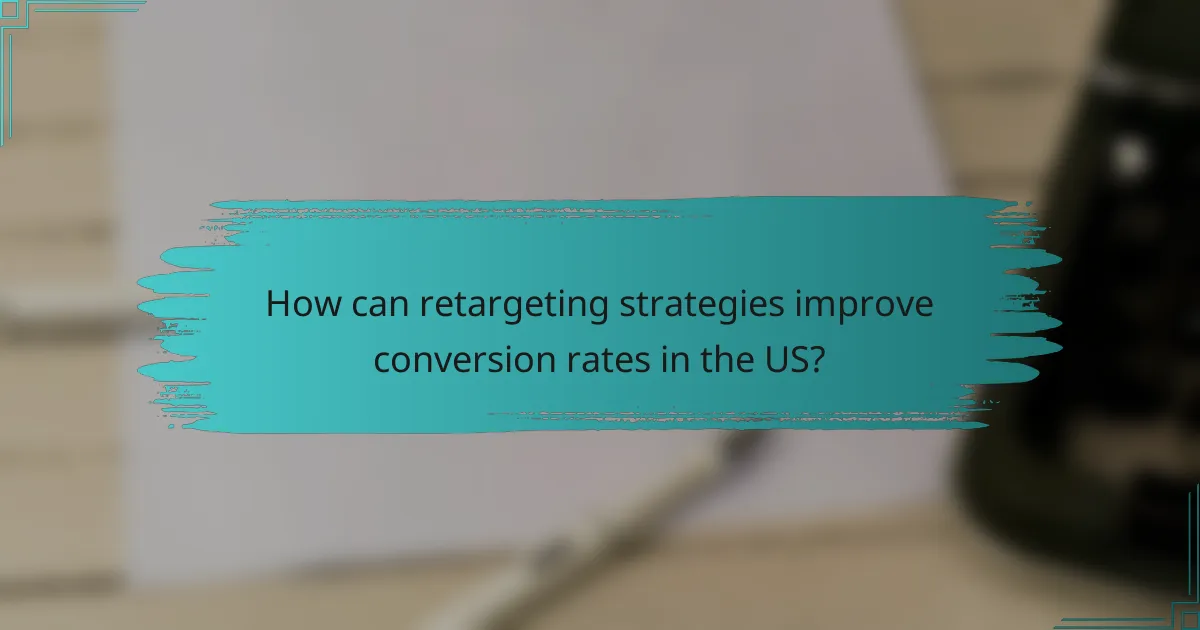Retargeting strategies play a crucial role in boosting conversion rates by reminding potential customers of products they have previously viewed, encouraging them to finalize their purchases. By utilizing targeted display ads, businesses can effectively re-engage interested visitors, enhancing customer retention and driving repeat purchases. With various ad formats available, such as dynamic product ads and video ads, companies can strategically increase customer engagement and loyalty.

How can retargeting strategies improve conversion rates in the US?
Retargeting strategies can significantly enhance conversion rates in the US by reminding potential customers of products they previously viewed, thus encouraging them to complete their purchases. By displaying targeted ads to these users, businesses can effectively re-engage interested visitors and drive them back to their websites.
Increased brand recall
Retargeting helps reinforce brand awareness by repeatedly exposing potential customers to your products. When users see your ads multiple times across different platforms, they are more likely to remember your brand when they are ready to make a purchase.
For example, a user who visits an online store but leaves without buying may see ads for that store on social media or other websites. This consistent visibility can keep your brand top-of-mind, leading to higher chances of conversion later on.
Higher click-through rates
Retargeting campaigns typically achieve higher click-through rates (CTR) compared to standard display ads. By targeting users who have already expressed interest in your products, these ads are more relevant and compelling, prompting users to click through to your site.
Studies suggest that retargeted ads can have CTRs that are several times higher than traditional ads. This means that investing in retargeting can yield a better return on your advertising spend, especially in competitive markets.
Personalized ad experiences
Personalization is a key advantage of retargeting strategies. By tailoring ads based on users’ previous interactions, businesses can create a more engaging experience. For instance, showing specific products that a user viewed or related items can increase the likelihood of conversion.
To implement effective personalization, consider segmenting your audience based on their behavior. For example, you might create different ad sets for users who abandoned their carts versus those who browsed without purchasing. This targeted approach can lead to improved engagement and higher conversion rates.

What are effective display ad formats for retargeting?
Effective display ad formats for retargeting include dynamic product ads, video ads, and carousel ads. Each format serves a unique purpose and can significantly enhance customer engagement and conversion rates when used strategically.
Dynamic product ads
Dynamic product ads automatically showcase products that users have previously viewed on your website. This format personalizes the shopping experience, reminding potential customers of items they showed interest in, which can lead to higher conversion rates.
To implement dynamic product ads, ensure your product catalog is up-to-date and integrated with your advertising platform. Consider segmenting your audience based on their browsing behavior to tailor the ads effectively.
Video ads
Video ads are engaging and can convey complex messages quickly, making them an effective retargeting tool. They can showcase product features, customer testimonials, or brand stories, capturing attention and encouraging users to revisit your site.
When using video ads, keep them concise—ideally under 30 seconds—to maintain viewer interest. Platforms like YouTube and social media channels are ideal for deploying these ads, as they allow for targeted placements based on user behavior.
Carousel ads
Carousel ads allow you to display multiple products or messages within a single ad unit, enabling users to swipe through different options. This format is particularly useful for showcasing a range of products or highlighting various features of a single product.
To maximize the effectiveness of carousel ads, use high-quality images and compelling copy for each card. Aim for a clear call-to-action on the last card to encourage users to take the next step, whether it’s visiting your site or making a purchase.

How does customer retention relate to retargeting?
Customer retention is closely linked to retargeting as it focuses on re-engaging previous customers who have shown interest in your products or services. By utilizing retargeting strategies, businesses can remind these customers of their offerings, thereby increasing the likelihood of repeat purchases and enhancing overall customer loyalty.
Re-engagement of previous customers
Re-engaging previous customers through retargeting involves displaying ads to users who have previously visited your website or interacted with your brand. This can be achieved through various channels, such as social media and display networks, which serve tailored ads based on user behavior.
For example, if a customer browses a specific product but does not complete the purchase, retargeting ads can remind them of that product, often leading to a higher conversion rate. Effective re-engagement strategies can include personalized offers or discounts to entice the customer back.
Cost-effectiveness of retaining customers
Retaining existing customers is generally more cost-effective than acquiring new ones, making retargeting a valuable strategy. Studies suggest that the cost of acquiring a new customer can be five to twenty-five times higher than retaining an existing one. By focusing on retargeting, businesses can maximize their marketing budgets.
Additionally, retargeting campaigns often yield higher returns on investment (ROI) due to the familiarity and trust established with previous customers. Businesses should consider allocating a significant portion of their advertising budget to retargeting efforts to enhance customer retention and drive sales.

What metrics should be tracked for retargeting success?
To measure retargeting success, focus on key metrics such as conversion rate, return on ad spend (ROAS), and customer lifetime value (CLV). These metrics provide insights into how effectively your retargeting campaigns are driving sales and retaining customers.
Conversion rate
Conversion rate is the percentage of users who complete a desired action after being retargeted. This metric is crucial as it indicates how well your ads resonate with your audience. A typical conversion rate for retargeting campaigns can range from 2% to 10%, depending on the industry and the effectiveness of the ad content.
To improve conversion rates, consider A/B testing different ad creatives and messaging. Tailoring your ads to reflect the specific interests or behaviors of your audience can significantly enhance engagement and drive more conversions.
Return on ad spend (ROAS)
Return on ad spend (ROAS) measures the revenue generated for every dollar spent on advertising. A healthy ROAS typically falls between 4:1 and 10:1, meaning for every dollar spent, you earn four to ten dollars in return. Monitoring ROAS helps you assess the financial effectiveness of your retargeting efforts.
To optimize ROAS, focus on targeting high-intent users and refining your ad placements. Avoid overspending on low-performing ads and regularly analyze which segments yield the best returns to allocate your budget effectively.
Customer lifetime value (CLV)
Customer lifetime value (CLV) estimates the total revenue a customer will generate during their relationship with your brand. Understanding CLV is essential for evaluating the long-term impact of your retargeting campaigns. A higher CLV indicates that your retargeting strategies are successfully fostering customer loyalty and repeat purchases.
To enhance CLV, implement strategies such as personalized offers and loyalty programs. Engaging customers post-purchase through targeted emails or exclusive promotions can encourage repeat business and increase their overall value to your brand.

What are the prerequisites for successful retargeting campaigns?
Successful retargeting campaigns require effective pixel implementation and precise audience segmentation. These elements ensure that ads reach the right users at the right time, maximizing conversion rates and customer retention.
Pixel implementation
Pixel implementation involves placing a small piece of code on your website to track visitor behavior. This code collects data on user interactions, allowing you to retarget those who showed interest in your products or services.
Ensure that the pixel is correctly installed on all relevant pages, especially those where conversions occur, such as product pages and checkout processes. Regularly test the pixel to confirm it captures data accurately, as any errors can lead to ineffective retargeting.
Segmentation of audience
Segmentation of audience is crucial for tailoring your retargeting efforts. By dividing your audience into specific groups based on their behavior, interests, or demographics, you can create more personalized and effective ad campaigns.
Consider segmenting users who abandoned their shopping carts, those who visited specific product pages, or customers who made a purchase in the past. This targeted approach can significantly improve engagement and conversion rates, as ads will resonate more with the audience’s previous interactions.

How can businesses optimize their retargeting efforts?
Businesses can optimize their retargeting efforts by employing data-driven strategies that focus on audience segmentation, ad personalization, and continuous performance analysis. Effective retargeting not only increases conversion rates but also enhances customer retention through tailored messaging.
A/B testing of ad creatives
A/B testing involves comparing two or more versions of ad creatives to determine which performs better in engaging the target audience. By systematically changing elements such as images, headlines, or calls to action, businesses can identify what resonates most with potential customers.
To conduct A/B testing effectively, select a clear objective, such as click-through rates or conversion rates, and ensure that each version is shown to a similar audience size for accurate results. Aim for a testing duration that allows for sufficient data collection, typically a few weeks, depending on traffic volume.
Common pitfalls include testing too many variables at once or drawing conclusions from insufficient data. Focus on one element at a time to maintain clarity in results and avoid confusion.


